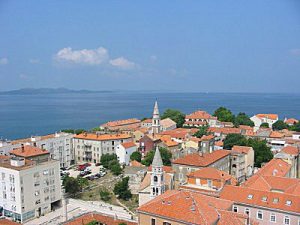Zadar is a city of northern Dalmatia in Croatia, more than three thousand years old and located on the Adriatic Sea. It is the second largest city in Dalmatia and the fifth largest in Croatia. Zadar is full of historical and cultural insights and by the natural location and environment is very attractive and touristic heritage.
Climate
Zadar enjoys a marginal climate of sub tropical and Mediterranean type. The temperatures drop to around 6.5 degree Celsius in January and range around 25 degree Celsius in July. The winters are mild while the summers are hot and humid.
Biodiversity
Biodiversity of Zadar comprises of exceptional natural beauty, crystal blue lakes, waterfalls, unique landscape rich in diverse range of flora and fauna.
History
During the 9th century B.C. Zadar was inhabited by the Illyrian Liburnian tribe who were later conquered by the Romans during the end of 3rd century B.C. Zadar ultimately became a colony of the Romans by the 1st century B.C. During the 6th and 7th centuries Zadar eventually was settled by the Croatian-Hungarian kings. In the mid 12th century Zadar was ruled by the Venetian empire but later declined because of frequent Turkish attacks and wars. In the 20th century it became an Italian province but later during the World War II, Zadar was taken over by the Germans.
Geography
Zadar measures a total land area of about 194Km2. It is surrounded by hundreds of islands and isles. It is separated by the narrow strait known as the Zadar Strait from the archipelagos of Ugljan and Pašman of Croatia.
Places of Interest
 St. Donat’s Church is the best sustained and excellent building of Zadar. It is considered to be the most significant building of Zadar. It has now become a museum where cultural programs are held. There are 34 churches present in the old town that carries substantial history. The oldest among them is the St. Simeon. St. Mary is also one of them. St. Anastasia is the most popular cathedral. The oldest university of Croatia also one of the oldest in Europe is the University of Zadar that was established in 1396. There is also the Archaeological Museum. Light and Sound of the Sea Organ on Zadar’s Riva is another place of interest that attracts tourists. The remains and preservations of The Roman Forum is also an outstanding place to enjoy.
St. Donat’s Church is the best sustained and excellent building of Zadar. It is considered to be the most significant building of Zadar. It has now become a museum where cultural programs are held. There are 34 churches present in the old town that carries substantial history. The oldest among them is the St. Simeon. St. Mary is also one of them. St. Anastasia is the most popular cathedral. The oldest university of Croatia also one of the oldest in Europe is the University of Zadar that was established in 1396. There is also the Archaeological Museum. Light and Sound of the Sea Organ on Zadar’s Riva is another place of interest that attracts tourists. The remains and preservations of The Roman Forum is also an outstanding place to enjoy.
Population
According to the 2011 census, Zadar has a population of 75,082.
Government
The administrative area of Zadar is divided into the following 21 local districts:
1. Arbanasi
2. Bili Brig
3. Bokanjac
4. Brodarica
5. Crvene Kuce
6. Diklo
7. Dracevac
8. Gaženica
9. Jazine I
10. Jazine II
11. Maslina
12. Novi Bokanjac
13. Poluotok
14. Ploca
15. Puntamika
16. Ricina
17. Smiljevac
18. Stanovi
19. Vidikovac
20. Višnjik
21. Voštarnica
The administrative area of Zadar also includes some islands and villages located nearby.
The villages include:
1. Babindub
2. Crno
3. Kožino
4. Petrcane
The islands include:
1. Ist
2. Iž
3. Molat
4. Olib
5. Premuda
6. Rava
7. Silba
Economy
The comprehensive economy of Zadar mainly depends on diversified industries and trade including sea trade, agriculture, fishing, farming, tourism, metal and non-metal manufacturing, mechanical engineering, chemicals, traffic and banking.
Transportation
The transportation in Zadar constitutes of airways, sea routes; roadways and railways through the interior of the city. It is an important traffic point.
And don’t forget Zadar, that is Trajadera
